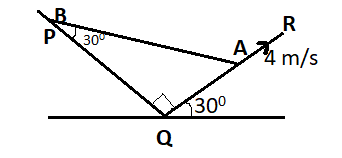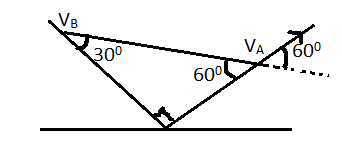
A rod of length $L$ is sliding on a frictionless surface as shown in the figure. Velocity of end $A$ is $4$$m/s$ along the wall. Find the velocity of end $B$, when and $B$ makes ${30^0}$ with wall $PQ$.

A) $8$$m/s$
B) $2\sqrt 3 $$m/s$
C) $4\sqrt 3 $$m/s$
D) $\dfrac{4}{{\sqrt 3 }}$$m/s$
Answer
218.7k+ views
Hint: In this question the rod of length is sliding horizontally on the frictional surface. The velocity of one end that is A is given. We need to find the velocity of the other end that is B in which angle is given. First find the angle of A and then find the velocity.
Complete step by step answer:
The rod is sliding on a horizontal frictionless surface then the gravity will be in downward and uniform. The force of friction is exerted by the object and the inclined plane is each other which is parallel to the surface of the plane but the normal force is perpendicular to the plane.

At the position A the angle is ${60^0}$then it becomes, ${V_A}\cos {60^0}$
At position B the angle is ${30^0}$, then we need to find the velocity at the end B
So,
$ \Rightarrow $ \[{V_A}\cos {60^0} = {V_B}\cos {30^0}\]…………(1)
The value of ${V_A}$ is $4$$m/s$
Substitute ${V_A}$ in the equation (1)
Then we get,
$ \Rightarrow $ $4 \times \cos {60^0} = {V_B} \times \cos {30^0}$
The value of $\cos {60^0} = \dfrac{1}{2}$ ,
And the value of $\cos {30^0} = \dfrac{{\sqrt 3 }}{2}$
If we substitute the value we get,
$ \Rightarrow $ $4 \times \dfrac{1}{2} = {V_B} \times \dfrac{{\sqrt 3 }}{2}$
$ \Rightarrow $ $2 = {V_B} \times \dfrac{{\sqrt 3 }}{2}$
$ \Rightarrow $ ${V_B} = 2 \times \dfrac{2}{{\sqrt 3 }}$
$ \therefore $ ${V_B} = \dfrac{4}{{\sqrt 3 }}$
The velocity of end B is $\dfrac{4}{{\sqrt 3 }}$$m/s$
So therefore option (D) is correct.
Note: If you put a grease into the kitchen sink, the grease all sticks inside the pipe and if you put the food particle it will stick into the grease and water backs up behind the blockage so all the pipes are in a frictionless coating.
Complete step by step answer:
The rod is sliding on a horizontal frictionless surface then the gravity will be in downward and uniform. The force of friction is exerted by the object and the inclined plane is each other which is parallel to the surface of the plane but the normal force is perpendicular to the plane.

At the position A the angle is ${60^0}$then it becomes, ${V_A}\cos {60^0}$
At position B the angle is ${30^0}$, then we need to find the velocity at the end B
So,
$ \Rightarrow $ \[{V_A}\cos {60^0} = {V_B}\cos {30^0}\]…………(1)
The value of ${V_A}$ is $4$$m/s$
Substitute ${V_A}$ in the equation (1)
Then we get,
$ \Rightarrow $ $4 \times \cos {60^0} = {V_B} \times \cos {30^0}$
The value of $\cos {60^0} = \dfrac{1}{2}$ ,
And the value of $\cos {30^0} = \dfrac{{\sqrt 3 }}{2}$
If we substitute the value we get,
$ \Rightarrow $ $4 \times \dfrac{1}{2} = {V_B} \times \dfrac{{\sqrt 3 }}{2}$
$ \Rightarrow $ $2 = {V_B} \times \dfrac{{\sqrt 3 }}{2}$
$ \Rightarrow $ ${V_B} = 2 \times \dfrac{2}{{\sqrt 3 }}$
$ \therefore $ ${V_B} = \dfrac{4}{{\sqrt 3 }}$
The velocity of end B is $\dfrac{4}{{\sqrt 3 }}$$m/s$
So therefore option (D) is correct.
Note: If you put a grease into the kitchen sink, the grease all sticks inside the pipe and if you put the food particle it will stick into the grease and water backs up behind the blockage so all the pipes are in a frictionless coating.
Recently Updated Pages
Two discs which are rotating about their respective class 11 physics JEE_Main

A ladder rests against a frictionless vertical wall class 11 physics JEE_Main

Two simple pendulums of lengths 1 m and 16 m respectively class 11 physics JEE_Main

The slopes of isothermal and adiabatic curves are related class 11 physics JEE_Main

A trolly falling freely on an inclined plane as shown class 11 physics JEE_Main

The masses M1 and M2M2 M1 are released from rest Using class 11 physics JEE_Main

Trending doubts
JEE Main 2026: Application Form Open, Exam Dates, Syllabus, Eligibility & Question Papers

Derivation of Equation of Trajectory Explained for Students

Hybridisation in Chemistry – Concept, Types & Applications

Understanding the Angle of Deviation in a Prism

Understanding Collisions: Types and Examples for Students

Understanding Atomic Structure for Beginners

Other Pages
JEE Advanced Marks vs Ranks 2025: Understanding Category-wise Qualifying Marks and Previous Year Cut-offs

Units And Measurements Class 11 Physics Chapter 1 CBSE Notes - 2025-26

NCERT Solutions For Class 11 Physics Chapter 8 Mechanical Properties Of Solids

Motion in a Straight Line Class 11 Physics Chapter 2 CBSE Notes - 2025-26

NCERT Solutions for Class 11 Physics Chapter 7 Gravitation 2025-26

How to Convert a Galvanometer into an Ammeter or Voltmeter




